
|
I see the contestants are making their way out onto the starting grid. This article was originally created as an entry for a Dark Crusade competition and is not official DJB canon content. It is preserved here for historical purposes only.
|
The Nfolgai system resides within the nearly-forgotten Stygian Caldera located in the Esstran sector of the Outer Rim Territories. Prior to the Hundred-year Darkness the system existed primarily as a haven for exiled Jedi, as the central planet remained prevalent as a bastion for further education in the the Force as well as Bogan.
The system is distinctively anchored by a massive, iridescent blue star called Nsuka, which in turn is flanked by the Nfolgai Belt. A single comet of relative worth passes through the system regularly--Zinthin; this comet is said to be the herald of imminent disaster on Nfolgai proper.
History
Nfolgai itself is relatively young compared the the bulk of the expansive Sith Space, numbering a mere few hundred million years. At odds with these numerical findings are the discovery of Cold War-era ruins, circa the Sith Empire, by the cartographers and exploratory parties dispatched from the Brotherhood; several leading scholars have since devoted invaluable resources to scientific discovery which will usher in new findings. Unfortunately, scavengers such as pirates, treasure hunters, and the ravaging effects of time have scoured these same ruins of countless artifacts; despite this, teams of confident researchers have continued to flock to Nfolgai in the hopes of unveiling the mystery that the system contains.
The first incursion of the exiled Jedi from the Second Great Schism actualizes the beginning of Nfolgai's exhaustive history. As the first exiles founded the harbor of what would later become Sith Space, the system itself transformed into the home base of the finest scholars as well as those who thirsted for knowledge which could not be explicitly expressed or easily obtained--this is the bridge to the original Sith order. While the system and its coordinates persisted in its shroud of secrecy, it is known that Nfolgai sustained an atmosphere suitable for humanoid life which explains the presence of Sorzus Syn--the Sith Lady potentially responsible for writing the original Sith Code. Following the Empire's loss in the Great Hyperspace War, the Nfolgai system faded to myth until it flourished primarily in the memory of lore-keepers, seers, and the like.
It is unknown if this territory was ever reclaimed during the rise of the Sith Empire which followed during the Cold War, though recent expeditions by Brotherhood scholars and cartographers are unearthing ruins which may confirm their presence. As time and history moved on much of Nfolgai and Sith Space remained vastly unexplored until the rise of the One Sith, a new Order which sought to restore the power of the Sith through subtlety and subterfuge. During their rise within Sith Space, a Sith Lord by the name of Yodb Nan was instructed to survey Nfolgai and the mausoleum of Sorzus Syn. As the Sith Lord performed his instructed excavation, the One Sith launched an offensive against their greatest foe, the Dark Brotherhood, an offensive which proved folly as the Brotherhood launched their own counter-offensive beginning with the Krayiss and Nfolgai systems. Leading this offensive was Clan Naga Sadow, House Plagueis, House Scholae Palatinae and House Tarentum; the units of the Brotherhood focused on claiming the planet as their own and wresting control of it from the One Sith through direct assassination attempts and a traditional invasion structure.
Astrography
Nsuka
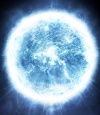
Nsuka is a class A main sequence star which serves as the focal point of the system's orbit; it is a brilliant, pulsing mass of blue energy which, like many class A stars, emits severely elevated levels of infrared radiation and causes a vast majority of surrounding innermost orbits to evolve into inhospitable places devoid of humanoid, animal, or plant life. Despite the stars relatively young age--a fleetingly few hundred billion years--as opposed to its kin and the system it inhabits, Nsuka is nonetheless well-established and includes seven individual orbits, the closest of which is a debris-disk unable to maintain body with its own orbit.
,Given its current state and size, it is predicted by Brotherhood astrologists that this star will eventually cool and settle into the state of a Red Giant; though that is beyond the many lifetimes of a great deal of those seeking to capture the system as their own.
Nfolgai Belt
The Nfolgai Belt is a circumstellar disk, or debris disk, maintaining the primary orbit around Nsuka. Comprised of various degrees of small rocks ranging up to dwarf planets, most of this debris was left over from the alpha stages of its creation and and had been unable to form larger bodies or establish their own orbital pattern. As much of this orbit receives direct bombardment of Nsuka's infrared radiation, the disk itself is large enough to contain the bulk of this radiation which renders most of the objects within uninhabitable but allows planets such as Nfolgai and beyond to support life. Local scans confirm large mineral deposits within numerous bodies within the belt, but also confirm absolutely zero life.
Solstice
The planet which exists in the second orbit of the Nfolgai system is an amalgam of the metaphysical and corporeal senses, with habits of rotation which fool the perceptions of many, if not all, humanoid minds. Called Solstice by Brotherhood research teams which were lucky enough to glimpse the planet during its third lunar rotation, it is now nearly devoid of all life.
Circa three centuries prior to the Hundred-year Darkness the sun orbiting Solstice imploded, leaving the planet a graveyard for that which once was. What had been lush, sub-tropical forests supporting abundant life--including but certainly not limited to the nomadic humanoid tribes, reptilian birds, carnivorous felines, and a vast variety of large, winged insects--gradually transformed into a virtually frozen, yet beautiful, wasteland. Previously, the planet had a 30 hour rotation period around its sun, with the moon nearly always appearing as a crescent faintly visible in the sky every third standard week. This all changed, however, with the aggressive growth of the sun.
The moon now dominated the rotation cycle, which ultimately affected more than just the life and landscape of Solstice. The planet became almost completely barren, the humanoid population dying out after its main source of food--the reptilian birds and, often, the insects--became extinct. The once abundant jungles withered and the soil left behind eventually formed what Brotherhood agents have called Winter Deserts; the sand is white in color, crystallized, and appears as smooth as glass. The three oceans, which had once consumed nearly half the planet's surface, froze into plains of sculpted waves that still appear to be moving with the tide.
The Northern Sea, known as Kathym, is now a vast, writhing mass of green crystal with-believe it or not-serpentine creatures somehow living beneath the surface. What kind of animal this is, as of recent logs, still unknown as it is still a recent discovery and thus not much is recorded on it. The surface of the Kathym Sea has a hypnotizing affect upon those who stare for too long into its depths.
The Eastern Sea, known as Akasa, is now a whirl of the same blue tones viewed as a vessel travels through hyperspace, although during the phase of Solstice's rotation period in which the planet can be viewed externally Akasa's colors appears to pulsate. So far, no life has been recorded to have ever existed here, although as Brotherhood agents continue to explore that finding may be subject to change. Those whom have journeyed there often return confounded for days at a time; the reason for this is as of yet unknown.
The third and final body of water, the Western Sea, is known as Kanaka. Its appearance is highly deceiving, as it glistens golden in color due to the unusually high amounts of a type of mineral--dubbed Mustafar minerals by Brotherhood agents--previously found in the water prior to the sun's implosion.
Nfolgai
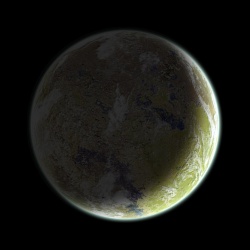
|
| Nfolgai
|
|
None
|
|
21 Hours
|
|
212 Solar Days
|
|
Terrestrial
|
|
18,628 km
|
|
Type I (Breathable)
|
|
Arid
|
|
1.0G
|
- Barren
- Jungles
- Mountainous
- Swamps
|
- Ancient Sith Mausoleum
- Natural Fission Reactor
- The Render crash site
|
|
Sith (Extinct)
|
|
|
|
Basic
|
|
1.1M
|
|
|
|
Minerals
|
|
|
- Main article: Nfolgai
Nfolgai is a treacherous, tidally-locked world infected with the Dark Side of the Force due to the planet's history of serving as a refuge for the exiled Jedi from the Second Great Schism. As these first exiles proclaimed themselves the first of the Sith Lords, they began to explore their surroundings in Sith Space, encountering the Nfolgai system and using it as a home for scholars and those who thirsted for knowledge amongst the fledgling Sith order. Despite the lack of knowledge, general or specific, concerning the system as a whole, it is known to have hosted nefarious beings of various dark affiliations--as already discussed with the example of Sorzus Syn--which shaped the attitude of Nfolgai.
Because the planet is tidally locked it only presents its southern hemisphere to Nsuka during its rotation, causing approximately half of the planet to produce life-forms of unnatural and often times grotesque development. Those charged with investigating these creatures rarely returned and those who did showed evidence of fungal growth on critical brain tissue; not long after this discovery the subjects died and no further attempt at scientific analysis with the world's more unusual specimens.
Due to the planet's steep axial tilt the northern hemisphere receives little light, thus making it relatively barren of plant life and largely desolate, with sweeping mountain ranges; volcanic activity is rampant and geothermal sites are relatively abundant. The lack of flora and highly active tectonic plates make the northern hemisphere ideal for mining endeavors due to its interestingly vast abundance of heavy metals and radioactive elements. At least one site in the northern hemisphere acted as a sort of natural fission reactor in the past where water-penetrating hydrothermal veins of uranium and thorium has acted as a neutron moderator and the system has cycled for over 1 million years naturally. This unique and natural erosion has created an area of easily mined enriched uranium ore.
While its rather devoid of life in the north, the southern hemisphere is dotted with jungles, swamps and eroded mountain ranges. The flora of the southern hemisphere contains exceptionally high metallic content similar to the planet of Myrkr; it is this same metallic content which renders radar and scanners useless.
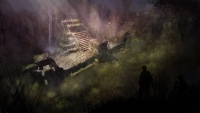 The entrance to Sorzus Syn's Mausoleum
The entrance to Sorzus Syn's Mausoleum
Located in the jungles of the southern hemisphere, Sorzus Syn's mausoleum remains a mystery within Sith Lore. It is unknown if the great Sith Lord was ever entombed within the facility or if it merely served as a house of power for her meditations, but several attempts to exhume the building have resulted in questionable findings which are released at a top-secret and need to know basis. Protected from aerial approach, the mausoleum is surrounded by heavy forest canopy and is carved out of the base of a mountainside, a seemingly natural process which has defied any endeavors at recreation. A great expanse within the mountain has been removed to house focusing chambers, tombs and the private alchemy-based studies of Sorzus Syn and other Sith Lords.
The mausoleum is defended by the enraged and mutated descendants of the slaves who were responsible for the erection of the structure. Mrlssi and Draethos prowl the jungles surrounding the temple and crawl through unknown passages within. Armed with rudimentary Force powers, telepathy, and crude weapons the Draethos provide one of the greater challenge of the indigenous aggressors. Additional traps and ancient wards protect the mausoleum's interior. Rumors exist of other abominations created to destroy even the greatest of Force Users looking to steal Sorzus Syn's secrets.
The world of Nfolgai continues to render many other wonders which were originally believed lost to the fantasy of myth. One of these, discovered in 35 ABY by the One Sith, the Interdictor-class Destroyer Render lies in the northern hemisphere of Nfolgai. The cause of the destroyer's crash on the planet's surface remains unknown, but the Captain of the ship did an exceptional job in preserving much of the structure as it crash-landed.
Abandoned over 3600 years ago, the Render is permanently crippled and the vessel's fate is now etched into the surface of Nfolgai. With destroyed power cores, a fractured hull, and over 3,000 years of the erosion of time have turned the ship from a mighty destroyer to a vast warren of Mrlssi descendants. Maddened by the Force, the bird-like creatures defend their home with an approach only definable as insanity.
Against conventional and logical reason, One Sith expedition teams have successfully breached the destoyer's surface hunting for artifacts and have returned with the belief that the Render does possess designs for ancient weaponry and armor.
Originally intended as a paradise in which scholars and scientists flocked, the events of the Great Hyperspace War caused the fame of the planet to falter and the focus shifted to Nfolgai transforming into a tomb world for the Sith who would remain behind. Somehow, they attempted to preserve their history and work for the future generations which would inevitably follow in their footsteps. Largely before the arrival of the One Sith, a small pirate force restored an ancient Sith station in orbit, refitting the likewise ancient fighters aboard as a small raiding party. While the station itself is largely ignored due to its nearly ruinous state, Aegis Station operates with a modest two squadron compliment and has remained largely inactive outside of harassing Brotherhood elements on the surface or destined for the surface.
It is known that Nfolgai was notably encountered by Lady Sorzus Syn as she searched Sith Holocron of King Nakgru and sought to learn more from the star maps of the ancient Sith Kings; pursuing the homeworlds of the slaves that they now used for further conquest.
Given the planet's historical significance, the One Sith themselves were present on Nfolgai since at least 35 ABY searching for anything of value to their cause. In the following year the planet became a target of the Dark Brotherhood following a failed attempt against them by the One Sith. The system itself was highly contested not just between the waring factions but also between Clan Naga Sadow, House Plagueis, House Scholae Palatinae and House Tarentum of the Brotherhood; each securing their own landing zones and Forward Operational Bases in different sectors on the planet. Their cooperation during the operation had been fragile at best with limited outbursts outside each encampment, but overall these frustrations did not disrupt their primary mission. Such cooperation was seen trying to claim the Mausoleum, in regular patrols of the system and in the orbital blockade preventing One Sith reinforcements and securing the pirate's Aegis station.
Aside from taking points of interest, Brotherhood forces were also advised to disrupt One Sith operations upon Nfolgai; chiefly by assassinating the Sith Lord Yobd Nan and claiming whatever relics or information possible from the expeditions of the Render's crash site. Brotherhood agents were successful en mass with several of these objectives and severely crippled the One Sith's efforts within the Nfolgai system.
Auberon
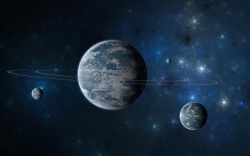
|
| Auberon
|
|
3: Leona, Phoebe & Selene
|
|
26 Standard Hours
|
|
537 Standard Days
|
|
Terrestrial
|
|
24,764 km
|
|
Type I (Breathable)
|
|
Temperate
|
|
1.5G
|
|
Aquatic (saturated hydrosphere)
|
- Auberon Complex Ruins
- Leona Facility Ruins
- Phoebe Chamber Ruins
- Selene Mausoleum Site
|
|
|
|
Water
|
|
Ancient Sith Empire
|
An aquatic world of massive size, Auberon contains a highly saturated hyrdrosphere marked by distinctive rings and a trio of satellites nicknamed 'the Three Sisters' by recent cartographers. The moons of these satellites are abnormally large and the possibility for classifying them as dwarf planets has been debated extensively by astronomers. Each of the moons increase in proportions relative to the one which came before it; also, while aquatic moons are not unusual, the trio of moons are actually an entirely aquatic cluster. Current conditions of Auberon and its satellites are still being uncovered by specialists and as of yet it is unknown if efforts to colonize this cluster will be successful.
 The Auberon Complex Ruins
The Auberon Complex Ruins
A beautiful and serene world, Auberon is captivating with its distinctive rings and orbiting children. It has clean and crystal clear waters which are full of various aquatic life while its surface undergoes a full gambit of weather conditions; ruins of a stilted city bear markings of erosion from powerful storms which resulted in entirely frozen surfaces for most of the planet. Designated as the "Complex" Ruins, these cities have been identified as former habitation and standard facilities for the Sith Empire. Unusually, these markings are not from the Ancient Sith Empire but instead from the Sith Empire of the Cold War, these installations believed to have been some form of research complex for the Imperial war-machine.
The largest moon of Auberon has been designated Leona and it is said that she has a nasty temper. Though it is highly aquatic the moon itself rampant with volcanism and its surface temperatures nearing a boil some days, couple this with its higher than normal rotational velocity causing a higher gravitational pull and the Leona is strife with violent storms causing turbulent skies and rough seas. Amongst the sisters, Leona is one of the fastest to complete her orbital period of Auberon and due to her violent climate also bears ruins from the days of the Sith Empire. These ruins are speculated to have been a focusing facility, both to draw energy from the violent winds and seas as a generator as well as for the Sith themselves to draw from the chaos surrounding them.
The next smallest moon bears the designation Phoebe and unlike her larger sister, is almost as calm and serene as her companion. Nearly identical to Auberon in many ways the only major difference between the pair is that Phoebe has a much solar rotational velocity than normal which results in a lower gravity than the other moons or planet and less frequent winds or storms. While sometime called an eerie calm, this peculiarity seems to have been utilized by the Sith Empire for meditation chambers, the ruins themselves almost lost to the seas from erosion but still bearing similarities to modern chambers.
The third and final moon is known as Selene, her orbital frequency the slowest of all the sisters to the point that she spends a bulk of her time in the shadow of Auberon or her sisters. This unique trait has meant that while her rotational velocity is average, her surface is desolate tundra nearly coated in ice. The ice and snow are so prevalent on Selene that her oceans are nearly covered in a thick sheet of ice. This solitary and desolated surface was selected by the Sith Empire for a Mausoleum, a facility which itself has practically frozen over from the neglect leaving Brotherhood specialists all the more intrigued by what secrets could lie within.
When the One Sith launched their expeditions on Nfolgai around 35 ABY, Auberon found itself left entirely alone as the Sith themselves were following information that had been within journals pertaining to the Sorzus Syn and her mausoleum. The following year Auberon and its moons found themselves utilized as a staging area for the Brotherhood's temporary refit and repair stations largely from its proximity to Nfolgai and its size, the larger size allowing the numerous ships of the combined invasion fleet to remain hidden from sight and the ships lurking within Auberon's rings could remain cloaked from sensor sweeps as the various particles would send false positives.
Solvanis
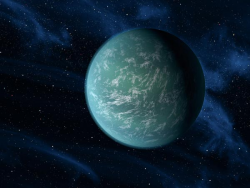
|
| Solvanis
|
|
1: Valem
|
|
37 Standard Hours
|
|
755 Days
|
|
Terrestrial
|
|
42,854 km
|
|
Type I (Breathable)
|
|
Temperate
|
|
1.95G
|
- Mountain
- Desert
- Plains
- Ocean
- Jungle
|
|
Indigenous Wildlife
|
The extremely large planet Solvanis has been until recently a complete mystery. The atmosphere suggests that Solvanis has just in recent years come out of a worldwide ice age. This would largely explain why the Ancient Sith chose not to colonize. Furthermore, no evidence exists to prove that any sort of civilization inhabited the planet previously, indicating that the planet may have been frozen a very long time. All current scans of the world show habitation is possible in all of its terrain regions with many edible varieties of flora and fauna.
The land mass of Solvanis is one giant continent, covering nearly 40% of the surface of the planet. Though there is only one continent, the terrains of the Northern and Southern hemispheres differ greatly. The Southern hemisphere supports the planets jungles and large expansive plains. Small mountain ranges create natural barriers between the jungles and expansive fields. Temperatures in this hemisphere are quite comfortable for most, ~78F at its warmest to ~21F at its coldest. The Northern hemisphere is home to the large mountains and hot deserts. Unlike traditional deserts, the mountains usually trap storm clouds creating substantial rainfall for the desert areas. While the deserts do get hot at their peak, nearly 110F, the presence of habitual rainfall sustains all kinds of plant and animal life.
The single moon, Valem, is a dead moon that cannot sustain any life. Absent of any water molecules or even minerals of any value, Valem's sole purpose is the regulation of the tides on Solvanis. The moon's orbit seems to have been affected by the strong gravitational pull of the planet. It follows and elliptical orbit due to the planet pulling the orbit closer towards its poles. An unexplainable phenomenon occurs when the moon comes into closer proximity to the planet; the tide does not surge as it should but rather the entire ocean seems to revert into a steady "calm".
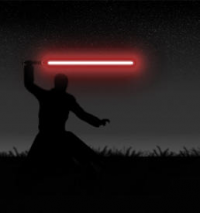 Brotherhood begins new training regiment
Brotherhood begins new training regiment
There is a slight draw back to the planets giant size. The gravity rests at just under two times standard gravity. The Brotherhood would eventually regard this as the planets greatest gift. The increased gravity gave way to new and innovative training techniques previously unpracticed. Pilots would have a whole new set of conditions to compensate for, duelists would have to work twice as hard to win, even hunters were outmatched by indigenous wildlife acclimated to the gravity.
Like its neighboring planet Auberon, Solvanis was ignored when the One Sith came to the Nfolgai system in 35 ABY. Due to the lack of previous civilization, the assumption was that there was nothing of importance on the planet. That lack of judgement would be reversed when the Brotherhood realized the planet itself could be used as a tool.
Necroia
Necroia is a Gas Giant with a metallic core. It is unknown which metal the core is comprised of because the electromagnetic field of the planet grows in strength as distance to the core shortens. This causes electronic devices to short and malfunction, which has killed many expeditions. The habitable area of the planet stays a moderately comfortable temperature of twenty-four degrees (~75F) and is habitable to humans, as it is comprised of Oxygen. The only civilization is Outpost 7, which was completely abandoned by Ancient Sith for unknown reasons. The only inhabitants are the many droids that maintain and keep the city afloat.
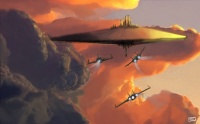 Brotherhood fighters on approach to Outpost 7
Brotherhood fighters on approach to Outpost 7
Necroia is surrounded by a small meteor belt and the only moon is technically an extremely large Asteroid that was caught by the gravity of the planet. The planet has few storms during it's yearly cycle. The storms only effect the habitable area by making it rain, but the water isn't drinkable unless it is thoroughly sterilized.
The planet was colonized by Ancient Sith for the mining of Tibanna gas. It is unknown why they abandoned the colony, but there are signs of foul play as if they had been attacked. All record stored in the droids is either corrupt or lost, as many of the droids were programmed to wipe their own minds every year to keep them from developing personality quirks. The Sith built chambers into the outpost that aid in meditation and even improve the flow of the living Force. The only way this could have been done is with a combination of alchemy and sorcery.
Information hints to there once being other installations on the planet, but they were either destroyed or fell into disrepair before falling into the core of the planet. The other installations are believed to have done the same function, which is mining Tibanna; although at least one would have had to have been a military installation to protect the others. The military installation would have been massive and it would have taken more than falling into disrepair to fall from it's orbit as it would have several backup generaters to keep it afloat.
Brotherhood forces sliced all the computer terminals on the outpost, but found little history on the installation. What they did find is that the Ancient Sith that built the station were mining more than tibanna from the planet, apparently they were somehow mining the metallic substance that comprises the core of the planet and replacing it with another metal of the same mass and viscosity. It's believed that the metal mined from the core either helps with alchemy or was used for ritualistic purposes.
After brotherhood forces started to get established in a small area of the outpost a datapad was found that detailed a fight with pirates that had apparently made their own installation far below the habital zone. The pirates started a small war with the Sith over the tibanna until they had found out the Sith were also after the metal in the core. The pirates then began attacking the Sith transports leaving the core and taking the metal for their own. The pirates didn't get away with much of the material before the Sith caught and killed them. The pirates had made a suit of armor out of the metal which the Sith kept and hid somewhere in one of the outposts. It is believed that it was in one of the destroyed installations as no record of it has been found in any of the Sith runes.
Moreila
The seventh planet in the Nfolgai system is a darkened jewel. At first glance, it seemed to be entirely covered in shadow. However, a closer inspection reveals a world of continents consisting of dark, igneous rock. These are surrounded by seas of black, clear water. Though this water lacks any silt or other contaminants to make it murky, it reveals only an endless dark abyss.
In documents found in the ruins on Auberon and Necroia, this world was called "Moreila". Though much of the text is ancient and difficult to decipher, the general impression first gained by Brotherhood scholars was of a world that is dead and of no value. It has virtually no surface life, whether flora or fauna. If the rocky service possessed any valuable minerals, they have since been mined out.
A more thorough scan of these ancient texts was conducted by the Krath Dark Side Adept Arion Aquillarum Solnatus. He found that , while the world's surface was barren and lifeless, it's seas teemed with life.
Ancient Sith teams had explored the oceans in their submersibles, but many had not returned. The texts spoke of massive, cruel sea creatures that were invisible until they moved in for the kill, or uses light to confuse their prey. On at least one occasion, one was documented from a distance. The passage spoke of a "long, clear body, punctuated by glowing orbs along it's back."
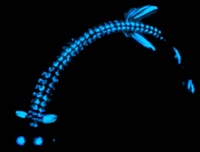 A rare image of one of the creatures found on Moreila
A rare image of one of the creatures found on MoreilaMany would discard these claims as fantasy, however in 36 ABY, as the Dark Jedi Brotherhood invaded, they made their own scans. Using modern technology and dropping probes into the waters, the Brotherhood was able to discover the presence of these creatures - shortly before their probes were lost. It is not known how these creatures survive on a world this far from the system's primary, but it is hypothesized that geothermal activity gives the seas just enough warmth for life, but keeps the water very cold.
The Dark Brotherhood's scans also indicated that the seafloor is rich in various valuable metals and other natural resources. The Brotherhood noted that these resources have likely not been claimed because they are effectively guarded by a hostile ecosystem in a dark, submarine world at crushing depths. It will take time to calculate whether it is worth trying to reach these resources.
Although scans reveal the ruins of small coastal bases and docks that are dated to the time of the old Sith Empire, there is no indication that the Sith Empire of the Cold War or of the One Sith ever attempted to claim these resources. It is unknown if they knew about them and decided they were not worth the effort, or simply scanned the world quickly and dismissed it as a dead planet of little value.
Moreila has one moon, which is approximately a third the size of the planet itself. The moon, named, simply, "Mior" in ancient Sith documents, is a dead rock with little to no atmosphere. It's dusty, rocky surface is believed to have separated from Moreila itself eons ago. The only notable feature of this moon is the remains of an ancient, crashed space station. It is possible that this station once orbited Moreila or its moon, or was placed somewhere in the vicinity, and was eventually abandoned. However, deep scans reveal signs of explosions where the station's positioning thrusters would have been, indicating that it may have been scuttled intentionally. This would explain how the station got on the moon, if it had originally been orbiting the planet itself, but not why it would have been towed to the moon.
Zinthin
Zinthin is a short-period comet within the Nfolgai system which is visible to Nfolgai proper every 50-55 years. Zinthin's periodic nature was suspected when the Ancient Sith Empire first arrived within the system and later confirmed by scholars as they studied more about their new home. As with most short-period comets, Zinthin's orbit has remained largely unchanged over the years with a typical 50-55 standard year frequency and maintains a highly elliptical orbit from Nsuka to (Orbit Seven). Unlike most small solar system bodies, Zinthin's orbit is actually in retrograde meaning that it has a counter-clockwise orbital pattern against that of the rest of the system; it is for this reason alone that Zinthin has been dubbed the herald of disaster for Nfolgai.
Like all comets, as Zinthin nears Nsuka, its volatile compounds (those with low boiling points, such as water, carbon monoxide, carbon dioxide and other ices) begin to sublime from the surface of its nucleus. This causes the comet to develop a coma, or atmosphere, up to 100,000 km across. Evaporation of this dirty ice releases dust particles, which travel with the gas away from the nucleus. Gas molecules in the coma absorb solar light and then re-radiate it at different wavelengths, a phenomenon known as fluorescence, whereas dust particles scatter the solar light. Both processes are responsible for making the coma visible. As a fraction of the gas molecules in the coma are ionized by the solar ultraviolet radiation, pressure from the solar wind, a stream of charged particles emitted by Nsuka, pulls the coma's ions out into a long tail, which may extend more than 100 million kilometers into space. Changes in the flow of the solar wind can cause disconnection events, in which the tail completely breaks off from the nucleus.
Despite the vast size of its coma, Zinthin's nucleus is relatively small: barely 15 kilometers long, 8 kilometers wide and perhaps 8 kilometers thick. Its shape vaguely resembles that of a peanut. Its mass is relatively low (roughly 2.2 × 1014 kg) and its average density is about 0.6 g/cm3, indicating that it is made of a large number of small pieces, held together very loosely, forming a structure known as a rubble pile. Ground-based observations of coma brightness suggested that Zinthin's rotation period was about 7.4 days. Scans taken by the various spacecraft, along with observations of the jets and shell, suggested a period of 52 hours. Given the irregular shape of the nucleus, Zinthin's rotation is likely to be complex.
Trivia
- The information gathered here was through special reconnaissance completed by members of the Naga Sadow Conclave
- The comet Zinthin was largely based off of Hally's Comet
- Team Members Include: Locke, Roxas, Methyas, Syntari, and Kairus